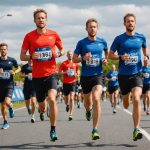Top Recovery Techniques for UK Cyclists: Essential Post-Ride Strategies for Long-Distance Success
For UK cyclists, particularly those engaging in long-distance cycling, recovery is as crucial as the training itself. Effective recovery strategies can make the difference between a successful ride and a grueling one, and even impact future performances. Here’s a comprehensive guide to help you optimize your post-ride recovery.
Understanding the Importance of Recovery
Recovery is not just about resting; it’s an active process that involves several key components to ensure your body is ready for the next ride. “Recovery is a critical part of the training process,” notes Alexys Brunel, a professional cyclist. “It’s not just about the physical aspect but also the mental and nutritional aspects”[2].
Also to read : Revolutionizing Training: The Role of Virtual Reality in the Development of UK Sports Teams
When you engage in cycling, especially long-distance cycling, your body undergoes significant stress. Your muscles, tendons, and joints are subjected to intense strain, and your energy stores are depleted. Without proper recovery, you risk injury, fatigue, and decreased performance.
Nutrition and Hydration
Immediate Post-Ride Nutrition
After a long ride, your body needs immediate replenishment of energy stores and hydration. Here are some key nutritional strategies:
Also read : Top Recovery Strategies for UK Marathon Runners: Effective Cool-Down Techniques After a Race
- Carbohydrates and Proteins: Consuming a mix of carbohydrates and proteins within 30-60 minutes after your ride helps in replenishing glycogen stores and repairing muscle tissue. Aim for a ratio of 3:1 or 4:1 carbohydrates to proteins[3].
- Hydration: Rehydrate with water or a sports drink to replace lost electrolytes. Aim to drink at least 16-20 ounces of fluid for every pound of body weight lost during the ride.
- Electrolytes: Include electrolyte-rich foods or supplements to replace lost sodium, potassium, and magnesium.
Long-Term Nutritional Strategies
- Balanced Diet: Maintain a balanced diet rich in whole foods, including fruits, vegetables, whole grains, lean proteins, and healthy fats.
- Periodized Nutrition: Adjust your nutrition plan according to your training phase. For example, during intense training periods, increase your carbohydrate intake to support energy needs.
- Supplements: Consider supplements like protein shakes, creatine, and branched-chain amino acids (BCAAs) under the guidance of a nutritionist or coach.
Active Recovery Techniques
Active recovery involves light physical activities that help your body recover without putting excessive strain.
Cycling as Active Recovery
- Easy Rides: Incorporate easy, short rides at a low intensity to promote blood flow and aid in the removal of waste products from your muscles.
- Cross-Training: Engage in other low-impact activities like swimming, walking, or yoga to maintain cardiovascular fitness without the high impact of cycling.
Self Massage and Foam Rolling
- Self Massage: Use a foam roller or your own body weight to massage your muscles, focusing on areas like the IT band, quadriceps, and hamstrings.
- Foam Rolling: Regular foam rolling can help reduce muscle soreness and improve circulation. Here’s a simple routine:
- IT Band: Roll from the top of your thigh down to your knee.
- Quadriceps: Roll from the top of your thigh down to your knee.
- Hamstrings: Roll from the back of your knee up to your glutes.
- Calves: Roll from the back of your ankle up to your knee.
Rest and Sleep
Rest and sleep are critical components of recovery, as they allow your body to repair and adapt.
Rest Days
- Scheduled Rest: Include rest days in your training plan to allow your body to fully recover. Aim for at least one or two rest days per week.
- Active Rest: On rest days, you can still engage in light activities like walking or stretching to maintain flexibility and blood flow.
Sleep
- Adequate Sleep: Ensure you get 7-9 hours of sleep each night. Poor sleep can lead to decreased performance, increased fatigue, and a higher risk of injury.
- Sleep Environment: Create a sleep-conducive environment by keeping your bedroom cool, dark, and quiet.
Compression Garments and Other Recovery Tools
Compression Garments
- Benefits: Compression garments can help improve blood flow, reduce muscle soreness, and enhance recovery.
- Use: Wear compression socks, tights, or sleeves during and after your ride. Here’s a comparison of different types of compression garments:
| Type | Benefits | Best For |
|---|---|---|
| Compression Socks | Improved blood flow, reduced muscle soreness | Long rides, recovery |
| Compression Tights | Enhanced recovery, reduced muscle oscillation | High-intensity rides |
| Compression Sleeves | Improved blood flow, reduced muscle soreness | Upper body exercises |
Other Recovery Tools
- Ice Baths: Cold water immersion can help reduce inflammation and muscle soreness. However, use it sparingly as it can also suppress the immune system.
- Electrical Muscle Stimulation (EMS): EMS devices can help stimulate muscle recovery by increasing blood flow and reducing muscle spasms.
Heart Rate Monitoring and Training Load Management
Heart Rate Monitoring
- Heart Rate Zones: Use heart rate monitoring to ensure you stay within your target zones during training. This helps in managing your energy expenditure and recovery needs.
- Recovery Heart Rate: Monitor your heart rate during recovery rides to ensure you are not overexerting yourself.
Training Load Management
- Periodization: Structure your training into periods of high intensity followed by periods of low intensity to allow for recovery.
- Training Plan: Develop a detailed training plan that includes rest days, recovery rides, and high-intensity training sessions.
Practical Insights and Actionable Advice
Here are some practical tips to help you integrate these recovery strategies into your cycling routine:
- Keep a Recovery Journal: Track your recovery activities, including nutrition, sleep, and any recovery tools you use. This helps in identifying what works best for you.
- Listen to Your Body: Pay attention to your body’s signals. If you feel fatigued or sore, it may be a sign that you need more recovery time.
- Seek Professional Advice: Consult with a coach, nutritionist, or physiotherapist to tailor your recovery plan to your specific needs.
Example Recovery Strategy for a Long Ride
Here’s an example of how you can structure your recovery after a long ride:
Immediate Post-Ride (0-60 minutes)
- Hydrate: Drink a sports drink or water with electrolytes.
- Nutrition: Consume a mix of carbohydrates and proteins.
- Stretching: Perform light stretching to help your muscles recover.
Short-Term Recovery (1-24 hours)
- Active Recovery: Engage in a light, easy ride or cross-training activity.
- Self Massage: Use a foam roller or self-massage techniques.
- Compression Garments: Wear compression socks or tights.
- Sleep: Ensure you get adequate sleep.
Long-Term Recovery (24-72 hours)
- Rest Days: Include rest days in your training plan.
- Nutritional Adjustments: Adjust your nutrition plan to support recovery.
- Heart Rate Monitoring: Monitor your heart rate to ensure you are recovering adequately.
Recovery is a multifaceted process that requires attention to nutrition, hydration, active recovery, rest, sleep, and the use of recovery tools. By integrating these strategies into your cycling routine, you can enhance your performance, reduce the risk of injury, and enjoy a more sustainable and successful cycling career.
As Alexys Brunel aptly puts it, “Recovery is not just about the physical aspect but also the mental and nutritional aspects. It’s what makes the difference between a good cyclist and a great one”[2].
So, the next time you finish a long ride, remember that your recovery is just as important as your training. Make sure to prioritize these essential post-ride strategies to ensure you are always ready for your next cycling adventure.











